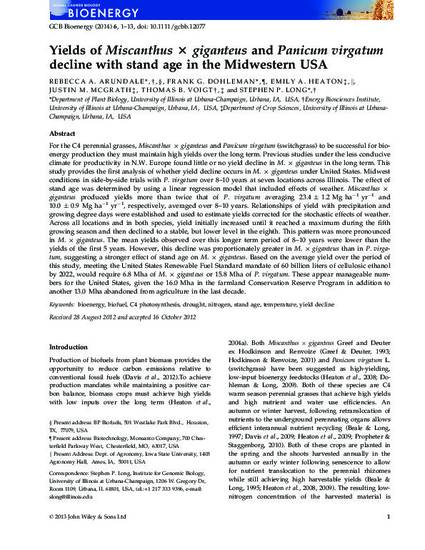
Article
Yields of Miscanthus × giganteus and Panicum virgatum decline with stand age in the Midwestern USA
GCB Bioenergy
(2014)
Abstract
For the C4 perennial grasses, Miscanthus × giganteus and Panicum virgatum (switchgrass) to be successful for bioenergy production they must maintain high yields over the long term. Previous studies under the less conducive climate for productivity in N.W. Europe found little or no yield decline in M. × giganteus in the long term. This study provides the first analysis of whether yield decline occurs in M. × giganteus under United States. Midwest conditions in side-by-side trials with P. virgatum over 8–10 years at seven locations across Illinois. The effect of stand age was determined by using a linear regression model that included effects of weather. Miscanthus × giganteus produced yields more than twice that of P. virgatum averaging 23.4 ± 1.2 Mg ha−1 yr−1 and 10.0 ± 0.9 Mg ha−1 yr−1, respectively, averaged over 8–10 years. Relationships of yield with precipitation and growing degree days were established and used to estimate yields corrected for the stochastic effects of weather. Across all locations and in both species, yield initially increased until it reached a maximum during the fifth growing season and then declined to a stable, but lower level in the eighth. This pattern was more pronounced in M. × giganteus. The mean yields observed over this longer term period of 8–10 years were lower than the yields of the first 5 years. However, this decline was proportionately greater in M. × giganteus than in P. virgatum,suggesting a stronger effect of stand age on M. × giganteus. Based on the average yield over the period of this study, meeting the United States Renewable Fuel Standard mandate of 60 billion liters of cellulosic ethanol by 2022, would require 6.8 Mha of M. × giganteus or 15.8 Mha of P. virgatum. These appear manageable numbers for the United States, given the 16.0 Mha in the farmland Conservation Reserve Program in addition to another 13.0 Mha abandoned from agriculture in the last decade.
Keywords
- bioenergy,
- biofuel,
- C4 photosynthesis,
- drought,
- nitrogen,
- stand age,
- temperature,
- yield decline
Disciplines
Publication Date
January, 2014
DOI
10.1111/gcbb.12077
Publisher Statement
© 2013 John Wiley & Sons Ltd
Citation Information
Rebecca A Arundale, Frank G Dohleman, Emily A. Heaton, Justin M Mcgrath, et al.. "Yields of Miscanthus × giganteus and Panicum virgatum decline with stand age in the Midwestern USA" GCB Bioenergy Vol. 6 Iss. 1 (2014) p. 1 - 13 Available at: http://works.bepress.com/emily-heaton/36/
Creative Commons license

This work is licensed under a Creative Commons CC_BY International License.
